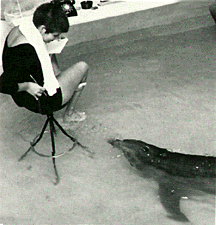
VOCABULARY
Basic vocabulary for both pronunciation and comprehension: numbers (1-5); personal names (Peter, Margaret, me, you); greetings (hello, bye-bye); objects (ball, toy fish, bucket, bobo clown, kinipopo, baby block); actions (speak, listen, come, go, give me, etc.).
To teach number, it is planned to use a series of balls with hooks in each end. The balls can be easfly put together by the operator in any combination or taken apart. Many ways can be used to teach numbers. Th e human can hold a string of balls and point at the balls as she says them . . . "one, two, three," etc. The human can hold a string of two in one hand and a string of -three in the other, and correspondingly show that one is two, one is three. Addition and subtraction are endless.
One problem is to teach the dolphin to say the name of the number, rather than to teach him to m eke the appropriate number of sounds for numbers. First, have the dolphin repeat after you. Second, demand that the dolphin name, number, or count the series of balls you hold up without you speaking.
So little is known as to what dolphins do and do not know about color. I suggest this not be among the first lessons, as the response of the dolphin may be nil anyway. Use wooden plaques all the same size and shape. the only difference being their color. First, have dolphin repeat after you; second, demand that the dolphin nanne the color as you hold up the plaque.
Shape can get involved with various named angles and so on, but I suggest one begin with basic shapes. Use wooden plaques of the same approximate size and color, with the only difference being shape. As above, dolphin comprehension can be kept track of by first having the animal repeat after you and, second, demanding that the animal name the shape of the plaque that you hol,d up.
If we are going to get into small sentences with these dolphins, it seems essential that names be used, both proper, "Peter," "Margaret," etc.; also, such as "you" and "me" should be taught.
Greetings explain themselves. The only re;ason I used them at all is 1. as a signal ("bye-bye . . . Iesson is over," etc.), and 2. "hello" is such a natural thing bo say when entering a tank or a room. These are getting into the area where it is hard to know if the dolphin understands.
The list of objects can be changed according- to the animal and the surroundings. It should be flexible . . . if the dolphin should get an ashtray into the water and play with it, it should have a name.
I suggest, as with all of these words on the vocabulary lists, that once a word is learned and the meaning underood, it should not be allowed to lapse from the list. If Peter learns what an ashtray is, it should not then be put into another room and forgotten. It should become part of Peter's things and should be used;
Anatomy is a difficult area in that it is hard to get the dolphin to identify the object with the word. I suggest, when patting Peter's tail, to name it over and over. Then change to saying "tail" to him and coaxing him to offer you his tail.
Getting the animal into some sort of game is a good way to bring action. I "throw" ball. Peter, "GO GET IT" or "PICK IT UP." "BRING IT HERE" . . . "GIVE IT TO ME" . . ., etc. his list should be added as new actions are taught and played with. This is more readily done with human speaking and animal acting. Not until much later will we probably have such a thing as Peter telling me to "go and get" something (at that point I will become his most humble slave!).
The language lessons will use a basic vocabulary in various categories as follows:
